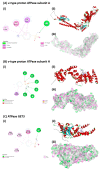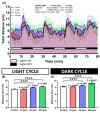Toxicity Assessment of an Anti-Cancer Drug of p-Toluene Sulfonamide in Zebrafish Larvae Based on Cardiovascular and Locomotion Activities
- PMID: 36008997
- PMCID: PMC9405983
- DOI: 10.3390/biom12081103
Toxicity Assessment of an Anti-Cancer Drug of p-Toluene Sulfonamide in Zebrafish Larvae Based on Cardiovascular and Locomotion Activities
Abstract
p-Toluene sulfonamide (p-TSA), a small molecular drug with antineoplastic activity is widely gaining interest from researchers because of its pharmacological activities. In this study, we explored the potential cardio and neural toxicity of p-TSA in sublethal concentrations by using zebrafish as an in vivo animal model. Based on the acute toxicity assay, the 96hr LC50 was estimated as 204.3 ppm, suggesting the overall toxicity of p-TSA is relatively low in zebrafish larvae. For the cardiotoxicity test, we found that p-TSA caused only a minor alteration in treated larvae after no overall significant alterations were observed in cardiac rhythm and cardiac physiology parameters, as supported by the results from expression level measurements of several cardiac development marker genes. On the other hand, we found that acute p-TSA exposure significantly increased the larval locomotion activity during the photomotor test while prolonged exposure (4 days) reduced the locomotor startle reflex activities in zebrafish. In addition, a higher respiratory rate and blood flow velocity was also observed in the acutely treated fish groups compared to the untreated group. Finally, by molecular docking, we found that p-TSA has a moderate binding affinity to skeletal muscle myosin II subfragment 1 (S1), ATPase activity, actin- and Ca2+-stimulated myosin S1 ATPase, and v-type proton ATPase. These binding interactions between p-TSA and proteins offer insights into the potential molecular mechanism of action of p-TSA on observed altered responses toward photo and vibration stimuli and minor altered vascular performance in the zebrafish larvae.
Keywords: cardiotoxicity; larva; neurotoxicity; p-TSA; zebrafish.
Conflict of interest statement
The authors declare no conflict of interest.
Figures















Similar articles
-
Evaluation of Effects of Ractopamine on Cardiovascular, Respiratory, and Locomotory Physiology in Animal Model Zebrafish Larvae.Cells. 2021 Sep 17;10(9):2449. doi: 10.3390/cells10092449. Cells. 2021. PMID: 34572098 Free PMC article.
-
Adverse effects of p-TSA-doped polypyrrole particulate exposure during zebrafish (Danio rerio) development.Colloids Surf B Biointerfaces. 2019 May 1;177:58-67. doi: 10.1016/j.colsurfb.2019.01.041. Epub 2019 Jan 24. Colloids Surf B Biointerfaces. 2019. PMID: 30711760
-
Mitochondrial dysfunction-based cardiotoxicity and neurotoxicity induced by pyraclostrobin in zebrafish larvae.Environ Pollut. 2019 Aug;251:203-211. doi: 10.1016/j.envpol.2019.04.122. Epub 2019 Apr 26. Environ Pollut. 2019. PMID: 31078959
-
Influence of Methylene Blue or Dimethyl Sulfoxide on Larval Zebrafish Development and Behavior.Zebrafish. 2023 Aug;20(4):132-145. doi: 10.1089/zeb.2023.0017. Epub 2023 Jul 4. Zebrafish. 2023. PMID: 37406269 Free PMC article.
-
Nickel exposure alters behavioral parameters in larval and adult zebrafish.Sci Total Environ. 2018 May 15;624:1623-1633. doi: 10.1016/j.scitotenv.2017.10.057. Epub 2017 Nov 6. Sci Total Environ. 2018. PMID: 29102187
Cited by
-
Zebrafish live imaging: a strong weapon in anticancer drug discovery and development.Clin Transl Oncol. 2024 Aug;26(8):1807-1835. doi: 10.1007/s12094-024-03406-7. Epub 2024 Mar 21. Clin Transl Oncol. 2024. PMID: 38514602 Review.
-
Application of a ImageJ-Based Method to Measure Blood Flow in Adult Zebrafish and Its Applications for Toxicological and Pharmacological Assessments.Biology (Basel). 2025 Jan 10;14(1):51. doi: 10.3390/biology14010051. Biology (Basel). 2025. PMID: 39857282 Free PMC article.
-
Paving the way for better ototoxicity assessments in cisplatin therapy using more reliable animal models.Front Cell Neurosci. 2025 Mar 5;19:1552051. doi: 10.3389/fncel.2025.1552051. eCollection 2025. Front Cell Neurosci. 2025. PMID: 40109278 Free PMC article.
References
-
- Yang S., Cha J., Carlson K. Quantitative determination of trace concentrations of tetracycline and sulfonamide antibiotics in surface water using solid-phase extraction and liquid chromatography/ion trap tandem mass spectrometry. Rapid Commun. Mass Spectrom. 2004;18:2131–2145. doi: 10.1002/rcm.1598. - DOI - PubMed
-
- Zhang Q.-Q., Ying G.-G., Pan C.-G., Liu Y.-S., Zhao J.-L. Comprehensive evaluation of antibiotics emission and fate in the river basins of China: Source analysis, multimedia modeling, and linkage to bacterial resistance. Environ. Sci. Technol. 2015;49:6772–6782. doi: 10.1021/acs.est.5b00729. - DOI - PubMed
-
- Daniel A.B., Aruldhas D., Joe I.H., Sasi B.A. Experimental and computational approach on p-toluenesulfonamide and its derivatives. J. Mol. Struct. 2020;1218:128503. doi: 10.1016/j.molstruc.2020.128503. - DOI
Publication types
MeSH terms
Substances
LinkOut - more resources
Full Text Sources
Research Materials
Miscellaneous

